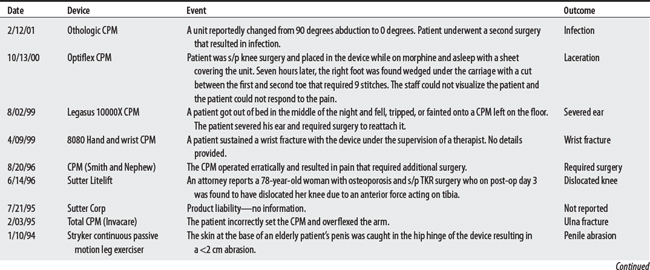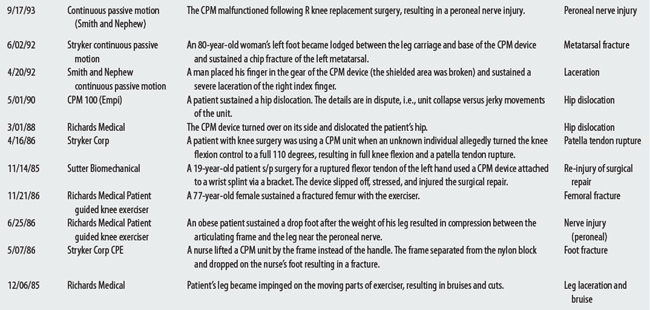Chapter 50 Continuous Passive Motion
OVERVIEW.
Continuous passive motion (CPM) devices provide uninterrupted, joint-passive range of motion over a controlled range and speed (slow) for up to 24 hours per day. The device is essentially a hinged, framelike machine with supports for the limb above and below the joint, a motor (A/C or battery), and controls for regulating the amount and speed of joint excursion. CPM was originally conceived to reduce the adverse effects of joint immobilization (i.e., adhesions, contracture formation, joint effusion, postoperative pain) by introducing controlled continuous passive motion soon after limb surgery. Concerns include the application of inappropriate forces that may either disrupt healing of tissue (skin, joint, bone, bleeding) or cause new injury (skin ulcers and nerve palsies).1
CONTRAINDICATIONS AND PRECAUTIONS
D50-D89 DISEASES OF BLOOD AND BLOOD-FORMING ORGANS AND CERTAIN DISORDERS
G00-G99 DISEASES OF THE NERVOUS SYSTEM
M00-M99 DISEASES OF THE MUSCULOSKELETAL SYSTEM AND CONNECTIVE TISSUE
1 O’Driscoll SW, Giori NJ. Continuous passive motion: theory and principles of clinical application. J Rehabil Res Dev. 2000;37(2):179-188.
2 U.S. Food and Drug Administration. Center for Device and Radiological Health. Available at: http://www.fda.gov/cdrh/mdr/. Accessed: November 7, 2005
3 Starkey C. Therapeutic modalities for athletic trainers, ed 2. Philadelphia: FA Davis, 1999.
4 Graham B, Loomer RL. Anterior compartment syndrome in a patient with fracture of the tibial plateau treated by continuous passive motion and anticoagulants. Report of a case. Clin Orthop Rel Res. 1985;195:197-199.
5 Adam KM, Thompson ST. Continuous passive motion use in hand therapy. Hand Clin. 1996;12(1):109-127.
6 Medical malpractice verdicts, settlements, and experts, July 1994, p 43, loc 1.
7 Medical malpractice verdicts, settlements, and experts, February 1998, p 24, loc 2.
8 Tan JC. Practical manual of physical medicine and rehabilitation: diagnostics, therapeutics, and basic problems. St Louis: Mosby, 1998.





















